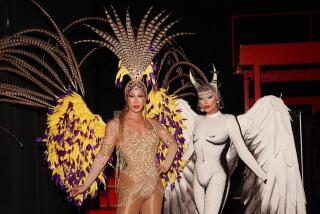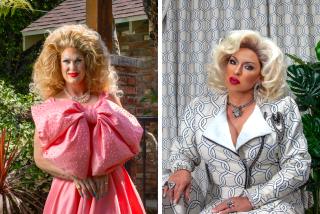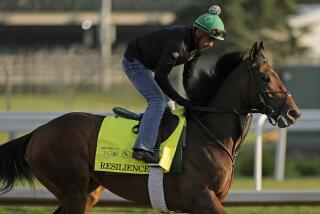HORSE POWER : Dressage Rider Yields Center Stage to Men Like Dimitrius, a Smug, Self-Absorbed Performer--and Every Bit a Steed
- Share via
You’ve heard of a male chauvinist pig? Dimitrius is a male chauvinist horse. He stands in his stall with a smug look of superiority as four women dote over him. They braid his mane. They rub baby oil around his nostrils. They smear black polish on his hoofs and white talc on his legs. They wipe the gook from his big brown eyes and brush his coat with a velvet cloth. He is king of the stable and they are his handmaidens.
“You want some sugar, sweetie?” says one of them, Betsy Allen, nuzzling him and talking baby talk. “I want you to look soooooo good.”
Dimitrius not only enjoys this royal treatment, he expects it. “He’s arrogant,” says his groom, Kathryn Zahlis, “and he gets even more arrogant right before a performance.”
Talk about karma. Some horses slog through a career behind a plow or on the kiddie birthday-party circuit. Tweezed, painted, polished, buffed and adored, Dimitrius spends his life in the fast lane--the best hay, the cleanest stalls--surrounded by fawning women who love him.
What Dimitrius gives them in return is a star performance in dressage, an Olympic event in which the horse does intricate maneuvers for a rider who can only provide nonverbal commands. Most horses are born with brains that can’t comprehend anything more complex than “giddyup” and “whoa.” Dimitrius understands thousands of commands and performs them well enough to compete in Grand Prix dressage, the sport’s major leagues.
There is a good chance that Dimitrius will be taking a round-trip plane ride to Europe this spring to represent the U. S. Equestrian Team. He won’t even have to eat airline food--his owner-rider, Marie Meyers of Newbury Park, will bring his own special supply.
It is Meyers who has been responsible for pampering Dimitrius--and turning them both into a world-class dressage team: They were the first alternate on the U.S. Olympic Equestrian Team last year.
But when Meyers bought the Dutch-born horse 12 years ago, Dimitrius was an excitable 3 year old, too unpredictable and undisciplined to make it big in dressage, and she was a 20-year-old rookie.
“He was crazy then,” Meyers says. “Women will shoot me, but he was too strong for me. He would have been better off with a man.”
This isn’t a pleasant chapter in Dimitrius’ otherwise storybook life. Meyers had him gelded. But the operation changed his attitude. Obedience is at the core of dressage--a horse’s compliance with his rider’s orders determines the score. Over years of patient training, Dimitrius and other blue-chip horses develop a rapport with their riders, who claim the relationship borders on the supernatural.
“There’s almost telepathy between Marie and Dimitrius,” Zahlis says. “He can sense what she wants and she knows what he needs.”
The bond is so close, Zahlis says, that “Dimitrius thinks Marie is his mother. He just tolerates the rest of us.”
The rest includes the 16 or so female students who help Meyers train horses. Meyers runs a sort of “Dressage U.” The students work for free at her barn in the Bell Canyon Equestrian Center, mucking stalls for the chance to pick up something more important--knowledge. “Marie is really generous with that,” Zahlis says.
When Meyers competes, Zahlis and another assistant are part of her team and get paid. Like Grand Prix auto racing, dressage has always been an expensive sport, dominated by wealthy Europeans, and getting more expensive all the time. Meyers bought Dimitrius for $4,000. Today, breeders get as much as $300,000 for a horse that already has been schooled. Travel, also costly, is a necessity to get exposure for the horse among judges and breeders.
At the Western World Cup Dressage Competition recently, Meyers rented 11 stalls at the L. A. Equestrian Center, four of them for her horses and the rest for equipment: saddles, blankets, tack, storage trunks, and a cooler-size vacuum called Electro-Groom. When it came time for Dimitrius to compete (called “performing a test”), he was groomed like a French poodle and put on his game face.
“You seem to be in a very good humor today,” Meyers whispered in his ear after getting in the saddle.
But you never know with horses. “Horses have lots of bad days, just like humans,” Meyers says, “but the problem is, they can’t let you know if they’re feeling crappy from the horse in the stable behind them kicking the barn door all night.” And Dimitrius can go into a funk. “He knows when he makes a mistake and he gets upset,” Zahlis says. “It’s like he let us down.”
With Meyers dressed in traditional black tails and derby, Dimitrius pranced into the Large Oval--a dirt ring 20 meters by 60 meters--and performed for the five judges. He looked relaxed and athletic--as if he, and not Meyers, had memorized the 24 precise maneuvers. Misty-eyed, Allen leaned on the fence and watched him actually skip across the ring, turning in the best showing of the competition.
“No matter what he does, I cry,” Allen says.
After riding, Meyers jumped off Dimitrius and got a hug from a fellow rider. “Fabulous trot,” the other rider said. “You had it going.”
Dimitrius was standing right there, with his usual smug look.
More to Read
Go beyond the scoreboard
Get the latest on L.A.'s teams in the daily Sports Report newsletter.
You may occasionally receive promotional content from the Los Angeles Times.










